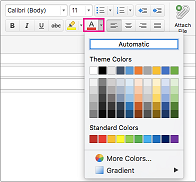

- CHANGE FONTS TO MAKE OUTLOOK FOR MAC ACCESSIBLE HOW TO
- CHANGE FONTS TO MAKE OUTLOOK FOR MAC ACCESSIBLE FULL
The following procedures describe how to add alt text to visuals and tables in your Outlook email. Screen readers also use header information to identify rows and columns.

Blank cells in a table could also mislead someone using a screen reader into thinking that there is nothing more in the table. If a table is nested within another table or if a cell is merged or split, the screen reader loses count and can't provide helpful information about the table after that point. Screen readers keep track of their location in a table by counting table cells. Use a simple table structure, and specify column header information. Ideally, each heading would include only a few paragraphs. And, organize the information in your email into small chunks. Use Heading 1, Heading 2, and then Heading 3, rather than Heading 3, Heading 1, and then Heading 2. To preserve tab order and to make it easier for screen readers to read your email, use a logical heading order and the built-in formatting tools in Outlook.įor example, organize headings in the prescribed logical order. Include ample white space between sentences and paragraphs.Īdjust space between sentences and paragraphs Avoid using all capital letters and excessive italics or underlines. For example, they may benefit from familiar sans serif fonts such as Arial or Calibri. They often see text merge or distort.įor people who have dyslexia or have low vision, reduce the reading load. People who have dyslexia describe seeing text "swim together" on a page (the compressing of one line of text into the line below). Use a larger font size (11pt or larger), sans serif fonts, and sufficient white space. White and black schemes make it easier for people who are colorblind to distinguish text and shapes. The text in your email should be readable in High Contrast mode so that everyone, including people with visual disabilities, can see it well.įor example, use bright colors or high-contrast color schemes on opposite ends of the color spectrum. Use sufficient contrast for text and background colors. For headings, consider adding bold or using a larger font. People who are blind, have low vision, or are colorblind might miss out on the meaning conveyed by particular colors.įor example, add an underline to color-coded hyperlink text so that people who are colorblind know that the text is linked even if they can't see the color. Tip: You can also add ScreenTips that appear when your cursor hovers over text or images that include a hyperlink.Įnsure that color is not the only means of conveying information.
CHANGE FONTS TO MAKE OUTLOOK FOR MAC ACCESSIBLE FULL
For example, instead of linking to the text Click here, include the full title of the destination page. Links should convey clear and accurate information about the destination. People who use screen readers sometimes scan a list of links. In alt text, briefly describe the image and mention the existence of the text and its intent.Īdd meaningful hyperlink text and ScreenTips. If you must use an image with text in it, repeat that text in the document. Visual content includes pictures, clip art, SmartArt graphics, shapes, groups, charts, embedded objects, ink, and videos.Īlt text helps people who can't see the screen to understand what's important in images and other visuals.Īvoid using text in images as the sole method of conveying important information.

Include alternative text with all visuals and tables. The following table includes key best practices for creating Outlook email that is accessible to people with disabilities. Windows: Best practices for making Outlook email accessible


 0 kommentar(er)
0 kommentar(er)
